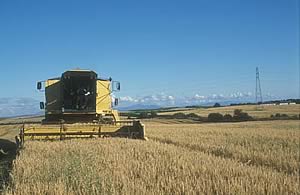22/09/08
Annual root evaluations at HGCA Recommended List second cereal trial sites across the country have highlighted a major build-up of take-all infections for the second year in a row.
This and persistently wet soil conditions ideal for the development of the disease means a serious crop health warning for second cereal growers, even with sowings well into October and beyond.
Averaging 61 on a 1-100 scale, the Take-all Index in the CEL second wheat trials at GS65-75 this summer was the highest recorded since routine NIAB root assessments began in 2005. Furthermore, severe infections (indexing more than 60) were recorded on 63% of the sites compared to 40% in last year’s high take-all season (Table).
Take-all Levels at Second Wheat Variety Trial Sites 2005-2008
| |
2005 |
2006 |
2007 |
2008 |
| Average
Take-all Index (GS65-75) |
37 |
17 |
46 |
61 |
| Severe
Infection * (% of sites) |
10 |
0 |
40 |
63 |
*
Take-all Index of 60 or more
The variation on the two worst affected sites (with Take-all Indexes of more than 89) was, indeed, so severe that they were not taken to official yield. And control yields on the three other sites indexing over 60 averaged 8.8 t/ha against the 10.39 t/ha overall trial mean.
“These results confirm that take-all has built up substantially over the past season from the high levels of infection recorded in our 2007 monitoring,” explains Monsanto agronomist, Rob Plaice who co-ordinated the monitoring. “And with full fungicide programmes but no take-all seed treatment, they also provide a good illustration of the scale of yield loss infections can cause if adequate safeguards are not put in place.
“A major carryover of inoculum from the 2007 crop combined with a warm wet season led to disease pressures that were only contained in commercial crops by the most robust preventative programmes and an almost complete lack of summer moisture stress. And even then whiteheads became evident in some cases.
“While the wet summer once again enabled many crops with quite badly compromised root systems to survive without excessive yield loss, it also allowed the fungus to continue proliferating widely,” he warns. “What’s more, soils damaged by one of the most difficult harvests on record and very wet seedbeds provide the ideal conditions for early take-all development this autumn. So 2009 looks set to present a particular disease challenge for second cereal growers.”
Under these circumstances, Rob Plaice strongly advises anyone drilling wheat or barley as a second cereal this autumn to use a seed treatment effective against take-all as a matter of course unless the risk from the disease has historically been very low. And this regardless of variety or drilling date.
“Delaying drilling until mid-October is definitely valuable in reducing take-all risk,” he points out. “But inoculum levels are so high this autumn and conditions so favourable for early disease infection that delayed drilling alone is most unlikely to prevent serious damage. Especially not if we get another mild, wet winter.
“The fact that all but one of last season’s CEL second wheat trials were sown after October 11 and the one most affected by take-all (with an Index of 99.5) wasn’t drilled until November 16 underlines the extent of the continued risk. And independent trials in East Yorkshire have shown an average yield response of over 1 t/ha from Latitude treatment of Einstein and Gladiator sown in the first week of December.
“At the same time as later drilling and robust take-all seed treatment, of course, anything that can be done to promote early root development and rapid crop establishment will be important in countering the take-all threat in the coming season,” Rob Plaice adds.
“Well-consolidated seedbeds, good pre-planting weed and volunteer control, and correct P&K fertilisation can make all the difference. And any seed dressings or early sprays that could impair or delay establishment should be avoided at all costs.”
 Earlier Wheat Harvesting Priority Grows Earlier Wheat Harvesting Priority Grows
 Eastern Europe Cereal Output on the Rise Eastern Europe Cereal Output on the Rise
 HO,LL Winter Oilseed Rape Harvest Impresses HO,LL Winter Oilseed Rape Harvest Impresses
|


